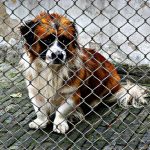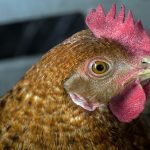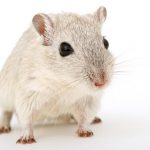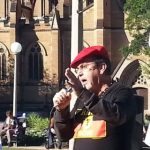Stop Animal Cruelty: An Interview with Anonymous for the Voiceless’ Matt Stellino
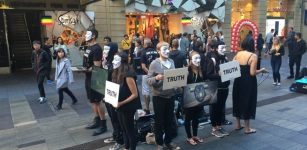
A group of black clad, Guy Fawkes mask wearing individuals were standing at the centre of the bustling crowd in Sydney’s Pitt Street Mall last Saturday holding laptops and flatscreens, displaying graphic footage of animals being treated with horrific brutality.
The silent protesters were part of the Sydney chapter of Anonymous for the Voiceless (AV): an offshoot of the global Anonymous network that focuses exclusively on animal rights. Rather than hacking computers, these activists take to the streets carrying out direct actions.
Standing three by three with their backs to each other, the volunteers formed what’s known as the “Cube of Truth.” And flickering on the screens they were holding was a collage of images revealing the mass slaughter of animals for human consumption.
These barbaric images are part of a four-minute clip called Thousand Eyes, which depicts standard animal agricultural practices in NSW and Victoria. Pitt Street Mall onlookers were horrified as they gazed at the footage.
One of the protesters, who was unmasked, told me that all of these farming practices are RSPCA approved.
Millions of lives taken
Australian Bureau of Statistics figures show that in March this year, 583,976 adult cows were slaughtered for human consumption in this country, along with 29,740 of their calves. There were 430,310 pigs that lost their lives, as well as 551,124 sheep, and a whopping 1,894,524 lambs.
Every year in Australia, 520-620 million animals are killed in the 300 slaughterhouses around the country. AV’s aim is to stop the slaughter, as well as to bring about an end to the barbaric farming conditions the animals are subjected to.
Take chickens for instance. In the year ending June 2012, 551 million were slaughtered across Australia. Most of these chickens are confined in overcrowded sheds. They’re pumped full of drugs so they grow at three times the normal rate, and part of their diet is made up of dead chickens.
A global movement
AV’s aim is to bring about the abolition of animal exploitation. In April last year, Paul Bashir and Asal Alamdari founded the group in Melbourne. Since then, they’ve spread around the globe, and the group’s headquarters is now in Chiang Mai, Thailand.
The direct action group are not only raising public awareness about the animal cruelty that pervades the meat industry. They’re also promoting the vegan lifestyle. AV offers the 22-day vegan challenge to onlookers who decide they want to take the option of a nonviolent diet.
Since their inception, AV has carried out over 348 demonstrations globally, and have convinced at least 12,144 bystanders “to take the needless violence in their diets and lifestyles seriously.”
The Sydney chapter
The first AV demonstration in Sydney was held on December 10 last year. On an average day, they convince around 150 to 160 onlookers to take up the vegan challenge.
Sydney Criminal Lawyers® spoke with Matt Stellino, co-organiser of the Anonymous for the Voiceless Sydney chapter, about the practices they’re exposing, the benefits of a vegan lifestyle and the story behind the man who made the documentary Thousand Eyes.
Firstly, Matt, Anonymous for the Voiceless are staging peaceful protests in Sydney showing a video, which documents cruel animal agricultural practices in Victoria and NSW that are RSPCA-approved.
Can you outline what some of these practices are that you’re exposing?
Some of the practices that we’ve exposed are looking at standard slaughterhouse techniques.
The gassing of pigs in the gas chamber, where they’re lowered in and are essentially gassed with carbon dioxide. This causes them a severe amount of pain. People are led to believe that it’s a passive sort of act and they drift off gently to sleep.
Another that we expose is the ineffectiveness of the captive stun bolt. The animals are meant to be rendered unconscious before they have their throats slit – showing how ineffective that can be on a daily basis.
Other methods are just a look inside what happens behind closed doors. The conditions the animals are kept in the slaughterhouse. And showing people that it’s not all green pastures, sunshine and rainbows, which is what the marketing labels on the meat packaging lead them to believe.
The video also shows what’s happening to chickens in the abattoirs. Can you tell us a bit about that?
There’s several things that are happening to chickens that most people don’t give a thought to.
That is the shredding of day-old male chickens. They’re put through a macerator, where they’re ground up alive for the simple crime of being born a male. They’re not able to lay eggs, and they’re not raised for meat, because they don’t grow those nice, lush breasts that everyone likes to eat.
The other footage is the chickens being pulled out of cages. They’re ex-layer hens that are not no longer able to lay, but they’re no longer able to lay profitably for commercial purposes. So they’re disposed of. That often happens to most layer chickens at somewhere between 18 months to 2 years of age. Even though, they lay for up to 4 years and live for up to 12.
That’s regardless of whether someone is buying cage, cage-free or free range eggs. They’re the steps required.
Most of the other footage is standard kill line. They have their throats slit by a circular saw blade, and then they’re dipped into a scalding tank of hot water.
What would you say AV’s main objective is in staging these graphic protests?
Our number one and ultimate objective is to have people remove this cruelty from their lives and move towards a vegan lifestyle.
What have the reactions of the general public been like when they witness this footage? Do you find that people are aware these practices are actually taking place?
The majority of people that stop make comments that make you believe they think it’s from overseas. We’ve had people say, “They really should end live exports. This stuff is terrible. What country did you film this in?”
When you tell them that it’s in Australia and you are able to name the slaughterhouses and give them the suburbs, it blows their minds. Those people have no idea. They really think that animals here in Australia get belly rubs and have their pillows fluffed for them, before they’re killed.
It really does blow their minds.
And the reaction that we’ve been getting from the public is mostly positive. Whether or not they acknowledge that they’re partly responsible for it through their consumption, they will at the very least, tell us we’re doing a good job and keep it up.
So these practices are taking place at regular slaughterhouses, and regular farms?
Correct.
AV promotes veganism. Can you tell us a bit about why an individual should pursue a vegan diet and lifestyle?
Absolutely. There’s a small difference between having a plant-based diet and veganism.
The medical data says that a plant-based diet is healthiest for humans. There’s no risk of any inflammation from eating only plants. There’s no cholesterol that comes from plants. There’s no heart disease.
It is quite healthy for the human body. You can get every vitamin and mineral that you need to sustain yourself and thrive from eating plants.
The key difference between that and veganism is vegans will also not wear wool, leather, fur – anything that’s caused an animal to be used in its production. So it’s more of an ethical ground between what you eat, and how you live.
The reason we advocate for people to move towards it is that we ask them a simple set of questions when they view the footage. That is if they agree or disagree with treating animals in this way. And whether it’s right or wrong in their mind to use an animal in that way. And most people disagree.
We ask them if they’d ever do it to an animal themselves and they say, “No.”
So the next two questions we ask them are, “If you saw somebody hurting an animal right here, right now in front of you, would your reaction be to intervene and help the animal or turn a blind eye and walk off?”
Most people say, unequivocally, that they would intervene and help the animal, and cause some sort of pain back to the person who is hurting the animal.
So we ask them to reflect on their own actions. And ask them, “If you were the individual hurting the animal, would you intervene on your own actions also?” And again, most people say, “Yes.”
The main reason we advocate for them to move towards a vegan lifestyle is not only because it’s better for the animals, the environment and their health, but it also allows them to live within their own ethical consistency.
AV promotes a 22-day vegan challenge. What does this involve? How many people are taking part in it? And what sort of outcomes are you having?
We promote the 22-day challenge, and one of the other organisations we work with called Vegan Easy run a 30-day challenge.
So we get people to sign up to either, or we encourage them to move towards thinking with their friends or family who are vegan. Most people know several vegans in this day and age. So simply go out and eat meals with them, and have them coach them.
So it’s not one-size-fits-all in how you apply it to your life. But most of the reactions that we get, we gauge from social media – how many people are coming onto our social media pages commenting that they saw us at a certain demonstration and how we opened their eyes.
I’d say, based on that, we get very good numbers in terms of conversion per demonstration.
Have you experienced any reactions from meat eaters, who somehow feel their position is being threatened?
Yeah, absolutely. We’ve had a varied response from every group, let’s say. We had one guy circling us. He did about two or three laps, yelling in the demonstrators faces. I guess trying to find a weak link to see who would flinch.
He was yelling out, “What are we meant to eat. Are we just meant to eat grass?” A very upset individual. He moved off without any sort of incidences.
The main resistance we get is from farmers who see the footage and say that we are poisoning their pool. Their claim is that we are trying to turn people against farmers. This could be further from the truth.
We don’t at any point claim that we could live without farmers. They provide food. We explain to them that we are simply asking them to change what they farm.
They think when they meet the average vegan that we’ve got absolutely no idea how to work the land.
The first thing that we ask farmers is, what their land is rated at. It’s scored in DSE, which is dry sheep equivalent and it denotes how much carrying capacity their land has. Land over 1 DSE – which most land in Australia is – can farm crops.
Once they know that we’re not just an uneducated bunch of university hippies and that we have actual research and logic behind our argument, most are willing to engage us in a conversation.
You’ve experienced criticism from passers-by who’ve questioned why you’re trying to help animals, because at the same time there are starving children around the globe. But there’s a link between people suffering hunger and the meat industry. Can outline what that is?
It all comes down to the allocation of resources. So people say that there are starving people in the world. And that is true. There is between 1 to 1.5 billion people who currently do not have enough food to put in their mouths.
And yet, worldwide we slaughter 56 to 60 billion land animals per year that don’t photosynthesize their energy. They’re eating crop that could otherwise feed the world.
It is a direct misallocation of resources.
What sort of laws are there in Australia protecting animals and their rights? And how effective do you think they are?
What we have is the NSW Prevention of Cruelty to Animals Act 1979.
Basically, in Australia you have two separate standards. You have the standards for animals that are raised for food, and that specifically excludes those animals from cruelty laws that protect cats and dogs, for instance. Even though, they do possess the same capacity to suffer and to feel pain.
There’s actually no current national standard to protect and oversee the treatment of animals that are raised for food. It’s left up to the individual states and territories to oversee their own welfare legislation. And in most cases that often falls woefully short of protecting even the most basic rights of the animals to keep them free from deliberate harm.
Most slaughterhouses and intensive farming practices do not have any surveillance cameras that can be logged into or screened that can allow an independent auditor to view them at any given time.
What sort of legislative reforms would AV like to see come about in the laws regarding animals and their rights?
It’s kind of a hard one, as most people will dismiss the idea that these things could happen, or that it’s bad, because we have these laws in place. These laws give people a false sense of security. So increasing the laws around animal welfare is a drop in the ocean, because people will then think it must be OK because we have new laws.
AV and other general organisations all share the abolitionist view – most of the volunteers do as well. What we want to see is at the very least consistency. That is the same laws that apply and protect domestic animals, apply for livestock.
And if that was to occur, that would make the industry, by default, illegal.
Sometimes after demonstrations we sit around and discuss how ridiculous the idea is that for all the emissions trading schemes and carbon taxes that have been introduced, not a single one of them ever proposed to tax the emission that come from animals.
Why the livestock industry was given this unspoken exemption, when they account for so much greenhouse waste gas, is ridiculous.
And lastly, Matt, AV was established last year in Melbourne, and has since spread throughout Australia and the globe.
What’s the next step for AV in broadening the scope of its message?
I contacted the actual original founder, Paul Bashir, about this. And he said his vision for the future is to see cubes in every possible city or town, basically, teaching or inspiring other vegans. That’s the first point.
The second is teaching aspiring vegans to do effective activism. And to maximise social media saturation, making it so people are more aware. Having people understand what the term vegan means. And why it should apply to their life.
There is one other point I’d like to make.
In the footage Thousand Eyes how many people do you think had criminal charges brought against them?
None.
Well almost. One did. Do you want to know who it was?
Who?
His name is Chris Delforce. He’s the guy who filmed the footage.
This is where we have such a problem with industry. You have all these laws that are meant to protect the animals, which aren’t enforced – so first of all there’s a massive double standard.
But what actually are enforced are the laws that protect the industry by making sure that nobody shines a light on what they’re doing.
So Chris Delforce – who made Thousand Eyes and the documentary Lucent and has the Dominion releasing soon – had his home raided. He had all of his surveillance equipment, laptop, everything seized by police.
And he received ten criminal charges in NSW. They basically allege that the dates that he filmed were under the Ag-gag laws. So he received the 10 charges under the NSW Surveillance Devices Act 2007.
Four charges were for using an optical surveillance device to record an activity, entry without consent, section 8. And six charges for publishing material obtained from an optical surveillance device, under section 11.
He has his court case coming up shortly. They’ve tried to charge him with an array of other ones. But after much to and fro this is where they settled. And it’s for the sheer act of wanting to protect animals.
Matt thanks very much for speaking with us today. And continued success with broadening public awareness around the sinister animal agricultural practices that are taking place in this country.
That’s OK. Thank you.



